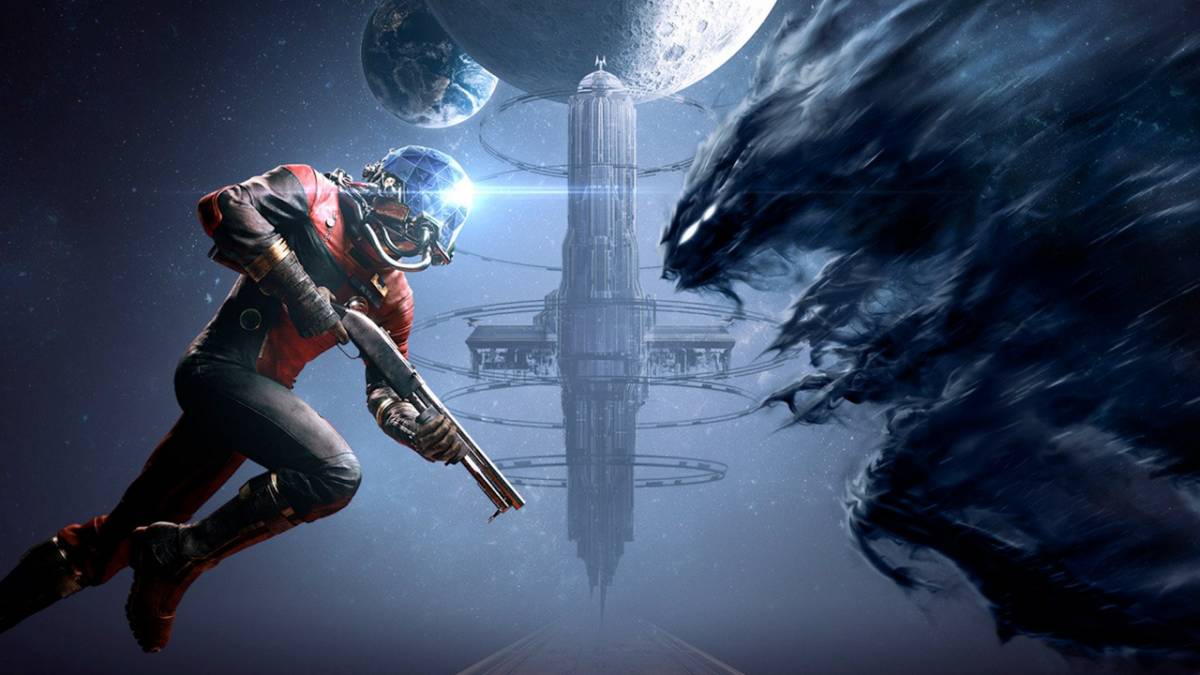WARNING: I’m going to harp on the bad to get it out of my system so I can spend the rest of this review praising what I love about Prey. Please keep that in mind as you read. And as always, my reviews are spoiler-free.
My first impressions of Prey were, as it turns out, fairly accurate representations of my feeling on the game as a whole, due in no small part to the fact that I was halfway through what would be my total play time of 31 hours – if you don’t have a good idea what you think of a game halfway through, something is wrong.
Many have praised Prey’s opening as strong, and while I agree that it wonderfully establishes the premise, setting and the central themes of scientific ethics and paranoia, I think it has one key fault – it makes the most interesting enemy grow stale before the meat of the game has been reached, giving way to the remainder of Prey’s extremely dull combat.
I speak of course about the Mimics. Long a staple of cruel dungeon masters in tabletop gaming, Mimics are present here more or less in the same way; shape-shifting creatures (or in this case, quantum-entanglement-manipulating creatures) who can become a perfect copy of any small-to-medium sized object in the environment. From the signature coffee mugs (the game even lampshades this in an experiment report regarding the creatures, noting their fondness for the form of the mug) to desk chairs, boxes and even enticing loot items like medkits and ammo, these things could be anywhere, anytime, waiting to ambush you.

Unfortunately, within the first hours of Prey, I found myself being completely over the novelty of the concept. Initially, they are put to good use, in a way that allows for fun gameplay – you can enter a room and, if you haven’t already caught a glimpse of it moving or transforming, look at the logical layout of the room and find the thing that doesn’t belong. This narrows down your chances of being caught off-guard and saves you the tedium of whacking everything with your wrench, your only starting weapon. Walk into a room with four desks but five chairs? The one on the floor tipped over is probably the Mimic.
This quickly gives way to rooms that are, understandably, filled with detritus and messes, making Mimics much more difficult to detect through any means other than aggro’ing them or returning to Wrench Bash City. Trouble is, at starting health levels on Normal difficulty, even these most basic of enemies hit hard – a quarter of your health or more, and extremely hard to avoid. Combine this with their quick, jittery movements and your lackluster weapon options, and fighting the Mimics gets old. Fast. Within the first few story missions you get a helmet of sorts, called a Psychoscope, and an upgrade for it that points out Mimics when you have it active. Thus, the game itself decides to relegate Mimics to a nuisance easily dispatched, squandering their potential.
The other enemies aren’t much more fun to fight either. While their design is at times captivating, and the lore and mythology behind their origin and ecology intriguing, the Typhon as a whole are not satisfying foes. The “grunt” unit, the standard one you fight most often, is the Phantom, which comes in different variants such as electrical, fire and a sort of “toxic” one that leaves behind a pool of harmful energy when it dies. Essentially a humanoid black smoke/goo monster, each variant has different attacks and a few slight tweaks to their behaviors and weaknesses, but can all teleport and have a ranged AoE ability.

There are a variety of ways to kill them – immobilizing them with the game’s most interesting tool, the Gloo Cannon, is always a good idea, then you can tear them apart at a molecular level with the laser gun, beat them to death, or just shoot them.
The problem is, when you do get around to killing a Phantom, or any of the other Typhon creatures, it never really feels all that satisfying on a visceral level. The Typhon have no real physics behind them when they are struck or killed; Phantoms will sometimes be blown over by a power strike with the wrench or a shotgun blast, but when they die or are struck by a thrown physics object, they simply dissolve into a pile of goo. I invested a lot of Neuromods (skill points) into my strength abilities, and when I throw a crate two times my size at a monster I expect some laughs. Instead, I get a fizzle.
The Typhon-abilities are a bit more fun, admittedly. Coming from researching the enemies with your Psychoscope scanner, you can gain the abilities of almost every Typhon, from the various elemental traits of the Phantoms to the ability to control organic and robotic entities with your mind like the Telepaths and Technopaths. Yes, you can even become a Mimic, and it’s extremely useful and hilarious. I experimented heavily with the various powers through quick saves and found them to be by far the superior way to navigate Prey – unfortunately, due to my immersion with the paranoia of the story and the game’s morality and themes, I resolved to not use a great many of these powers, lest I become the monsters I fight (which was my thinking, at least).
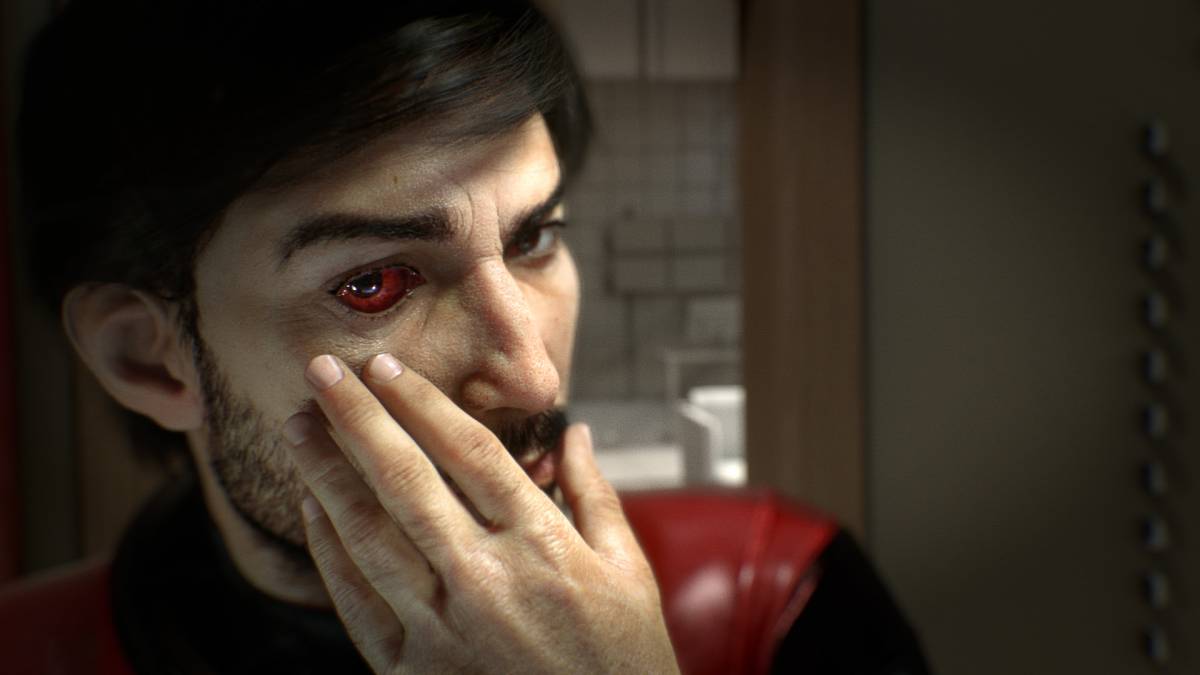
I had just enough Typhon powers to keep me below the threshold of the station’s turrets scanners seeing me as alien – I ended up with Remote Manipulation and Psychoshock, the former a basic form of telekinesis that also allows for remote usage of keypads and computers, the latter an offensive move that damages Typhon and, crucially, disables their Psychic abilities.
Now I know what you’re thinking – “You deliberately didn’t use the most fun tools the game gives you and you’re complaining you didn’t have fun?” My response to that is the same thing I’ve said about Arkane’s Dishonored series in the past – choosing a certain playstyle should not mean choosing to have less-polished and useful mechanics. I don’t mind that Prey is more challenging without the powers. I remedied this by min-maxing the shit out of the crafting and exploration and maxing out two of my “Human” skill trees by the end, resulting in a slo-mo ability and fully upgraded guns that did considerable damage with sneak and skill bonuses to boot, plus max health (three times the starting amount).
This didn’t fix the fact that the guns (of which there are only a pistol and shotgun, with the former having a stronger version found in a side quest) don’t feel particularly satisfying to use, and the improvised weapons like the stun gun, laser gun and various thrown gadgets are incredibly situational. Couple this with numerous enemies that have lots of cheap tricks and hit hard, and you have a recipe for combat tedium.
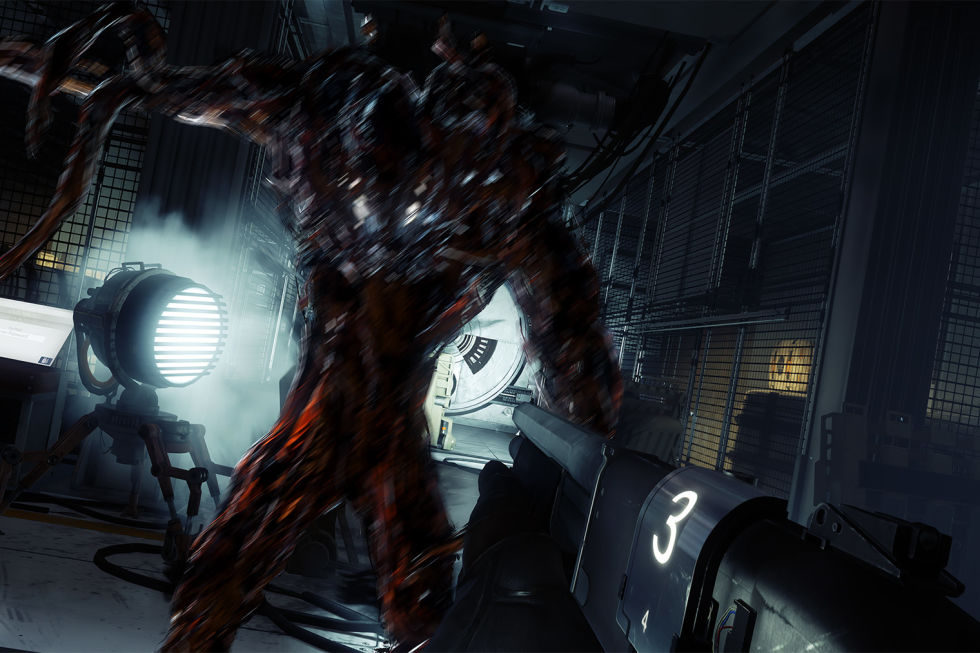
Stealth is a viable option in a utilitarian sense, allowing you to bypass most fights thanks to the well-designed environments. I didn’t find this to be much fun, especially with the same issues with inconsistent and seemingly arbitrary detection criteria that I’ve had with Dishonored; I’ve stood right in front of a Phantom and had it not notice me until I put a shotgun round into it, and I’ve also seen a Mimic in another room somehow detect me sitting still while crouching and come bolting in. I never did figure that out, if there even is anything to figure out.
A few of other quibbles that come to mind involve inventory management, quest bugs and audio issues. Your inventory is grid-based, almost identical to the one seen in the Deus Ex series. It is expandable through skill points, but I still found it filling up quite quickly at higher levels. The reason for this is that food items and junk do not stack with unlike items – a broken wire and a burned-out hard-drive, despite serving the same purpose (crafting ingredients), take up different slots, as do, say, a bag of candy and a banana. I can see that this was a conscious decision designed to challenge you to carry only the essentials, but I think junk at least should have all been on slot – or perhaps make it a side-benefit of higher level skills involving the inventory space.
As for bugs and crashes, I’m sorry to say there were some doozies. Prey hard crashed several times for no apparent reason, thankfully never too far from an autosave or quicksave, but nonetheless frustrating. The real problem were the several times where the game refused to complete important quests due to sequence breaks or unforeseen or unknowable glitches. The biggest offender was when I played a mission to save a significant portion of the surviving crew, only for the final objective to refuse to complete despite my success.

Some Googling revealed that I had inadvertently broken the quest by doing some things out of order – I had fixed a couple of things that were part of the quest before starting it, having found them on my own. Funnily enough, the game even acknowledged it by having several characters express surprise that I had already done what they needed, which further confused me as to why my actions broke the quest. This happened several more times, and each time forced me to replay at least an hour, if not more, of the game.
Even when it “works,” sequence breaking isn’t fully realized by the game; in one quest I killed a survivor who I discovered was not who they said they were (on my own, without the game explicitly telling me) and found that my suspicions were correct; I completed a sidequest I hadn’t even started simply by killing them, but the character who called me to complete the quest treated me like we had spoken previously, when we actually had not.
For a game that so openly encourages exploration and ingenuity to have shoddy and, at times, game-breaking bugs related to sequence-breaking that the game itself acknowledges as possible and has contingencies for in the story is simply baffling.

Finally, my issues with the audio and music continued from my previous check-in, and actually got worse in some respects. The single largest issues is characters talking over each other – the mixing for more than one voice source is basically non-existent, and everyone talks over each other. I hope more than two people in the same room don’t want to talk to you at once, because they will, and you won’t hear what either of them is saying. Heaven help you if someone else calls you on your TranScribe during all of this, or an intercom turns on.
I gave the music a few more tries as well, and while I found that it thankfully became less intrusive (and was quite good most of the time), it also had a lot of noises mixed in that I couldn’t tell whether they were ambient environmental audio or music. Ultimately, I played the majority of Prey with it off, just to ensure I could always hear my surroundings correctly. Sorry, Mr. Gordon!
Pivoting away from the negatives, let’s talk about what I consider to be the other (better) two pillars of Prey’s gameplay – exploration/navigation and crafting. In regards to the former, the Gloo Cannon manages to remain the most consistently amusing, useful and interesting piece of equipment Prey has to offer. Aside from being a combat tool, it has immense usefulness as a navigation tool, meshing beautifully with the game’s verticality and expertly-designed environments to allow you to create makeshift platforms of hardened goo to get where you want, when you want. The Gloo can also be used to block of hazards such as fires and leaking gas pipes, and temporarily insulate arcing electrical panels.
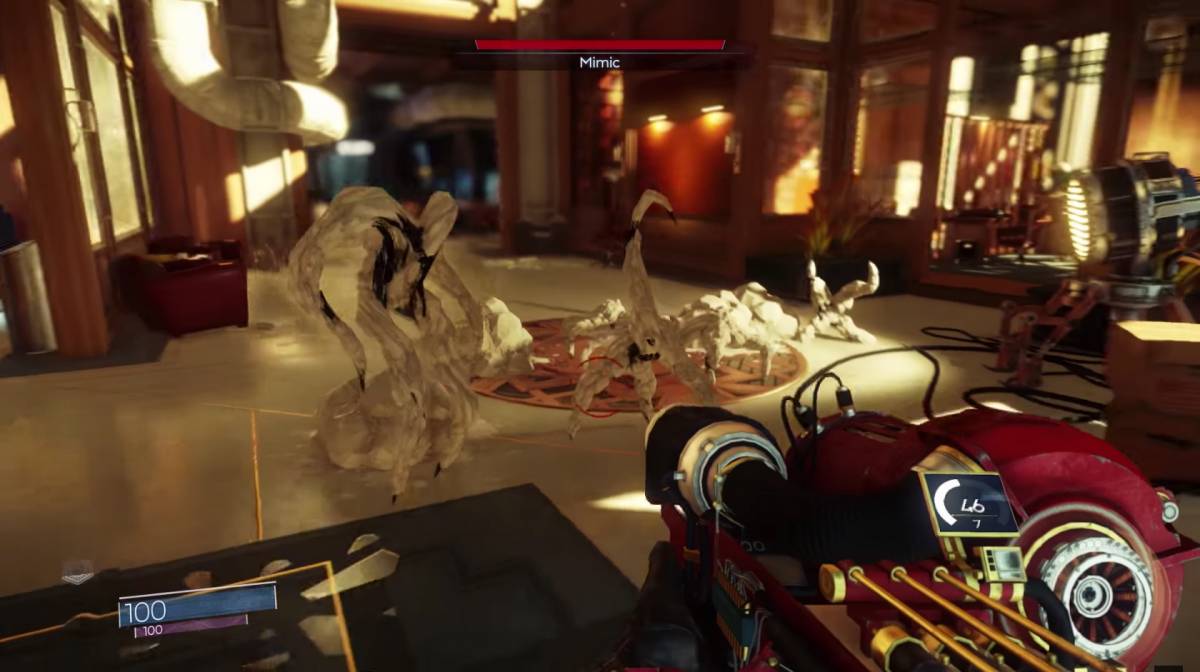
While certain skills and powers definitely aid in navigation, even a starting character with a Gloo Cannon can go a long way towards finding secrets, alternate routes and vantage points. Early on you also get a jet booster for your suit. While primarily used for navigation in the zero-G environments outside the station, it also provides an augment for your jump, giving you a little extra height and glide-assisted reach.
Speaking of zero-G, having the ability to exit the station any time you choose (so long as you can find an airlock) to explore or take a shortcut across the station is a handy thing. When you add in that the outside of the station is its own contiguous level, complete with secrets and loot to find and enemies to fight/avoid, the exterior gameplay really adds a unique element to the somewhat-crowded “claustrophobic sci-fi” genre.
I previously said in my impressions that the side quests irked me sometimes by sending me back and forth across the station, but I found myself warming up to this trend soon after. I realized that, if it weren’t for the fact that I was trying my best to beat Prey quickly for a timely review (yeah, that worked out didn’t it?), I probably wouldn’t care. The reason for this is that, with how well-laid-out the station is, the side quests that send you back and forth really help you get a feel for where everything is, what the fastest routes are, the safest, where crafting stations and other important stops are, etc.
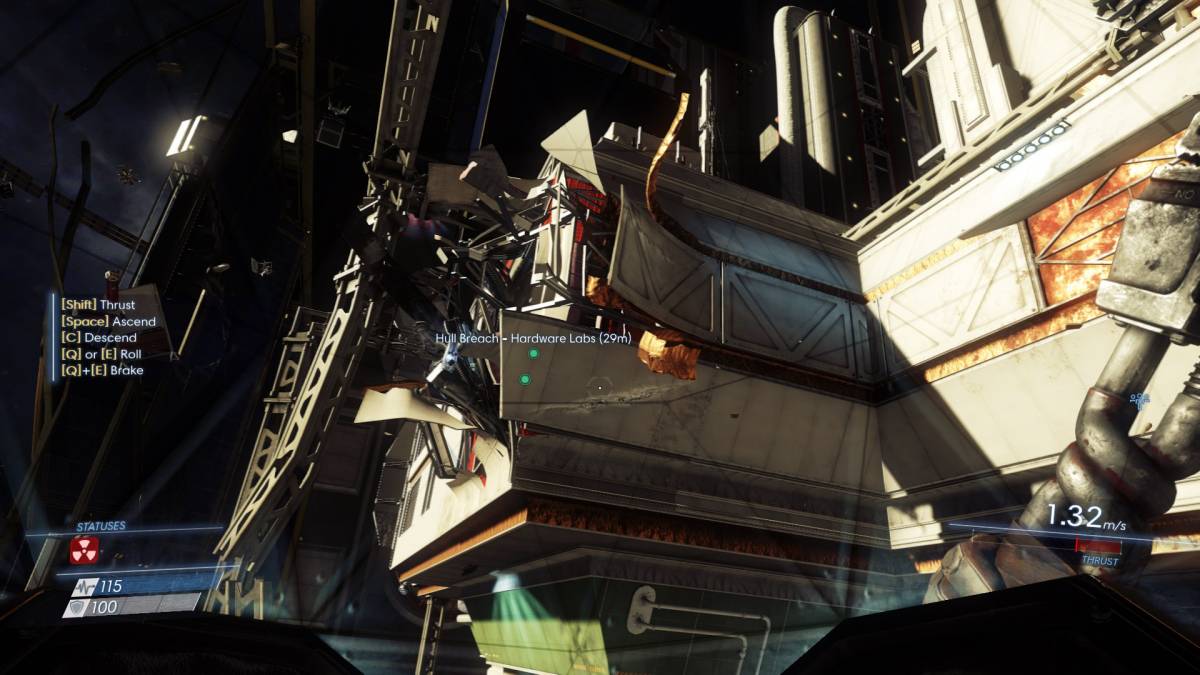
This knowledge is a godsend in some of Prey’s later missions that require timely navigation, and just for quality of life when making long treks in general – learning the station becomes part of the fun, finding new nooks and crannies that hide the loot and little vignettes that the moment-to-moment gameplay thrives on. It helps that environments, despite being on the same 800-meter long space station, vary so much, from the cold industrial utility of the Life Support and Power Plant to the art deco upper areas where the crew live and work, and even the greenhouse-like Arboretum that reminded me a lot of the Cloud 9 ship from Battlestar Galactica. Each of these is fully realized from the tiniest detail to the grandest macabre set piece, and cements Talos I as a setting with an immaculate sense of place.
The best part? Nearly all of the scenery and objects Prey’s gorgeous environments can be turned into little cubes and spheres of crafting material. While smaller objects such as scrap and extra weapons, ammo and items can be recycled in a Recycler machine, larger things like furniture, boxes and other scenery must be broken down using Recycler Charges. These grenades suck in anything nearby (including enemies and even you!) and break them down into one of four crafting materials.
These materials can then be brought to your local Fabricator to build anything you desire, provided you have the schematic for it. Unlike most games, these schematics are quite common, provided you explore a decent amount. Soon you’ll be able to craft ammo for any weapon you can conceive, build more EMP and Recycler grenades, weapon upgrades and even Neuromods, the scientific marvel at the center of Prey’s story and the conduit for your skill increases.
Many items can be found in abundance in the environment, again, if you journey off the beaten path a bit, but crafting is practically a necessity if you want to maximize your potential. As someone who generally dislikes and avoids crafting and building if at all possible, Prey’s crafting system is a joy. With only four crafting materials and an extremely simple but satisfying loop behind the acquisition of materials and their subsequent usage, kitting yourself out between missions or when the opportunity strikes is actually genuinely enjoyable.

I have yet to mention Prey’s story because, as I said in my impressions, it’s something best experienced cold. What I will say is that, having seen it through to the conclusion, I absolutely loved how the game handled morality – there is no binary karma system flashing in the corner when you do something, only the sinking feeling that somehow, somewhere, someone is judging you. And that it matters.
The game ends rather abruptly after you finish your choice of final quest with a short cutscene, but there is a post-credits “epilogue” that wraps everything up – it is here you see the results of your actions throughout. Though I did say earlier that I warmed up to the globetrotting nature of the side quests, I will say that you should prioritize them based on your play style and sense of morality – for instance, I focused less on quests with tangible rewards after a certain point (since I was pretty well-equipped) and went after the ones that involved saving people.
I did this not only because I assumed it was the right thing to do (and because I’m a nice guy), but because I wanted to hear more from the characters. The voice acting has no epic, sweeping performances or huge celebrity guests (except for a cameo by Walton Goggins that had the Justified fan in me positively giddy), but boy does it do its job. The various audio logs, radio calls and in-person conversations are well-written, and the way characters treat you really helps reinforce protagonist Morgan Yu’s unique and compelling position in the story.
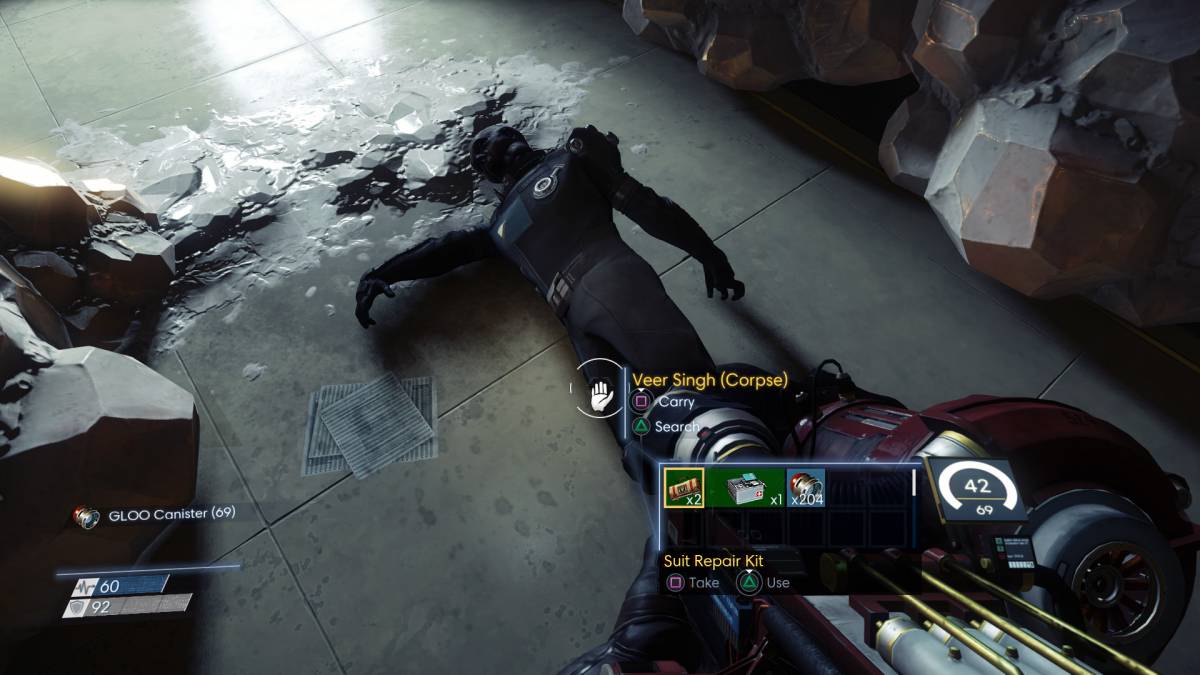
Revolving around scientific ethics, morality, the nature of identity and memory and so much more, Prey’s plot, the narrative that tells it and the characters that populate it are quite simply astounding at times, not because it is necessarily groundbreaking stuff, but because of just how perfectly it is integrated into gameplay and setting. Morgan him/herself is a silent protagonist, but s/he is a fully-realized character with a literal voice through both audio/video logs and another avenue I won’t spoil here. It is up to the player how much they embrace what they are told about Morgan’s identity and personality prior to taking control, and which of the opposing influences, both human and not so human, they listen to.
That’s the ultimate question Prey always comes back to: Can you trust anyone but yourself? Can you trust yourself?
Prey kept me hooked because, even as the credits rolled, hell, even when I made my final choice in the epilogue, I never could satisfy myself with an answer to those questions.
Copy purchased
Some of the coverage you find on Cultured Vultures contains affiliate links, which provide us with small commissions based on purchases made from visiting our site.
